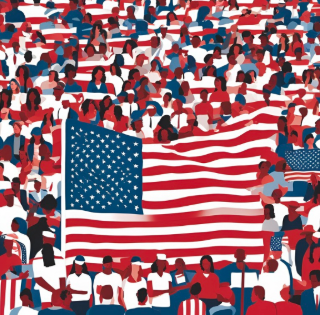Friday’s West Ottawa boys basketball game against Grandville opened with Karl Von Ins’ announcement of the national anthem. The crowd of over 700, including energized Black Hole students eager to show school pride, immediately stood and looked to the north end of the gym toward the flag. Beyond those in the pep band who were performing the anthem, no one else sat.
Before sporting events and significant ceremonies, the playing of the national anthem is inevitable. In the United States, standing up during the national anthem is expected; however, there has to be a point where individuals may feel inclined to sit in defiance to display their unhappiness with the choices of the government. If a woman’s right to vote was revoked, would this warrant individuals to sit in protest during our country’s unifying anthem?
For some people, the establishment of controversial policies would have no impact on their willingness to stand. Many believe the national anthem shows an appreciation for those who have given their lives to make the lives of others better. As a result, deciding to sit during the presentation of this song would be indicative of a lack of respect.
“The view that I and many I served with hold, is that the flag is representative of the freedoms and opportunities that make up this country and those who have sacrificed to defend these rights. When I stand to honor our country during the national anthem it is not to honor our government or the administration who runs it, but instead the many freedoms this nation affords us,” Instructor Ryan Klingeman said.
Klingeman is an army veteran and has experienced the sacrifice to obtain the freedom many take for granted today. Others with the same view as Klingeman don’t view the flag as a representation of the current government. They choose to stand regardless of what state the country is in because it displays their respect for those who have made the ultimate sacrifice. Ultimately, the decision to sit or stand doesn’t represent their opinions on the government’s decisions.
Nevertheless, Klingeman acknowledges that not everyone feels the same. The meaning of the national anthem will vary for each person.
“How a person views what the flag represents is a critical point in understanding this topic. There are two ways to look at this. One way is the flag represents our government. This is the view of say a person who refuses to stand for the national anthem in protest of something they view as an injustice,” Klingeman said.
For others, sitting during the national anthem would serve as a way to display their disagreement with the decisions of the government.
“If the government ever passed policies that went against those values, like taking away women’s right to vote or creating discriminatory laws, I would definitely consider not standing. To me, that would be a way of showing my disagreement and refusing to take part in a tradition that wouldn’t feel right under those circumstances. In my opinion, real patriotism and love for your country means working toward a better future for all of the people in it and sometimes that means challenging the way things are” Instructor Emma Jacobson said.
For Jacobson, sitting during the national anthem would allow her to advocate for change. Not only would she sit in protest of the controversial policies being put in place impacting her life, she would also sit to cultivate change for others who are impacted by the laws being enforced. Not standing during the anthem provides Jacobson and others with the ability to show the government they are unhappy with the administrative decisions.
“Sitting down for the national anthem would be a silent protest towards our government if I was truly unhappy with my living conditions. It’s like the bus boycotts during the Civil Rights Movement. African Americans stopped riding the buses and the bussing industries along with the cities were losing money. They gained the attention of the government because of the segregated spaces in the South including the buses. Imagine if a large group of students or sports fans sat down for the national anthem. If all of the fans at an NFL game sat down to make a statement. That would make national headlines drawing the government’s attention. Maybe even fixing the unjust laws they put in place” Sr. Addy O’Connell said.
O’Connell can attest that there is power in choosing to remain seated during the national anthem. Sitting for a song dedicated to our country represents a form of peaceful protest to advocate for change. Although refusing to stand is a simple action, it’s a harmless way to make one’s voice heard.
When deciding to sit or stand, the decision ultimately rests on how the individual views the national anthem. If one sees the national anthem as a powerful tool to cultivate change, they will not hesitate to sit in protest in the face of controversial policies. Conversely, if one sees the anthem as a symbol of respect for those who serve our country, they will not associate the government’s decisions with the anthem and always choose to stand. Amidst the chaos in our country, everyone has the choice to stand or sit during the national anthem. Ultimately, it’s up to the individual to decide how they will exercise this choice in the face of problematic policy implementation.









James Douglas Mandrick • Feb 19, 2025 at 11:27 am
Very interesting also would be curious as so many students chose to sit for the daily pledge: Is that apathy? Is it a political statement? Is it just its early in the morning?
Helen Sachs • Feb 19, 2025 at 1:19 pm
Thank you so much.
Yes, that is a very interesting point that you bring up. I’m curious what students want to be displaying when they choose to sit for the pledge: tiredness or defiance?
Thanks again!